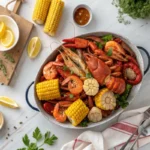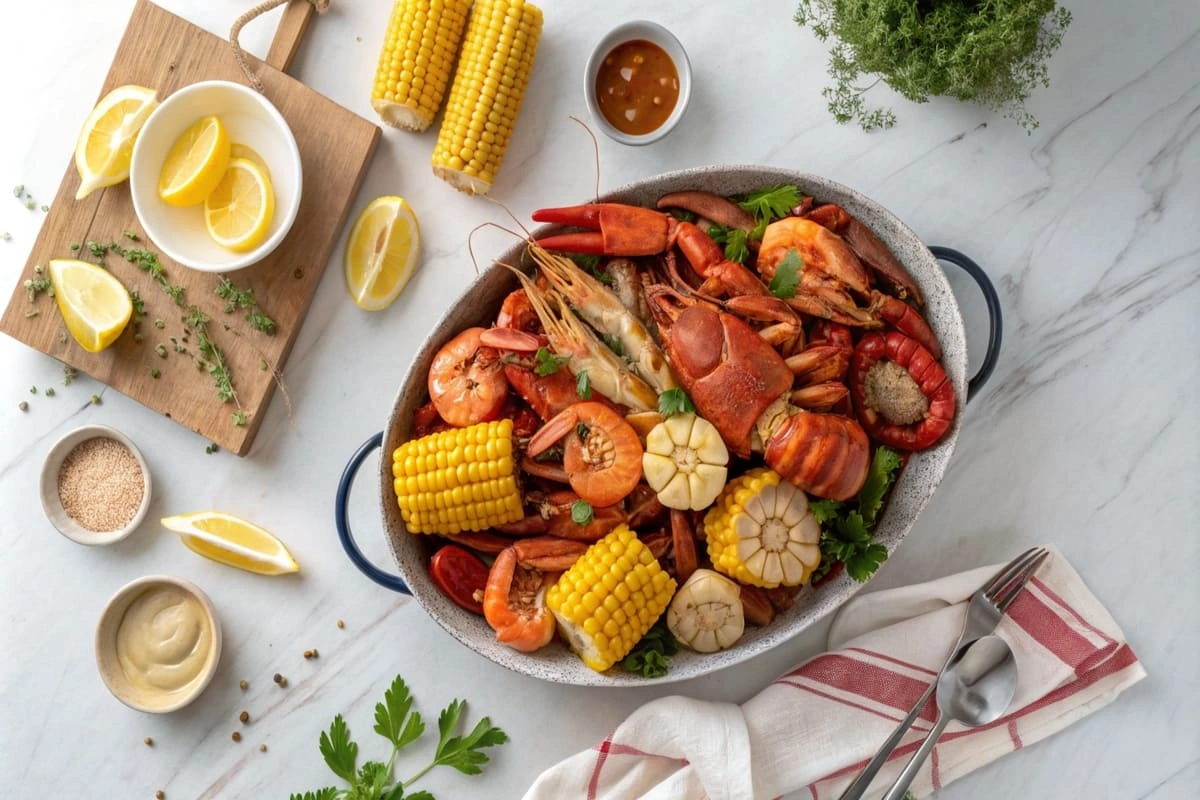Introduction
When you think of a special gathering near the coast, you often picture a big pot steaming with fresh shellfish. Seafood boil gatherings have become iconic in coastal areas, especially in the southern United States. Basically, they represent community, flavor, and celebration.
Meanwhile, these feasts did not arise overnight. Initially, coastal communities developed them out of necessity. Fishermen needed a fast, easy way to feed large groups. Eventually, the tradition spread inland as people discovered the fun of cracking shells and dipping morsels of shrimp or crab in butter. Accordingly, the seafood boil turned into a social event that unites friends, families, and neighbors.
The Culinary Roots of the seafood boil
The seafood boil started when fishermen along the Gulf Coast and Atlantic shores cooked fresh catches in big pots. This easy method made group cooking simple and ensured the shellfish stayed fresh. It also brought people together, sparking laughter, stories, and a shared love for local waters.
Eventually, European, African, and Native American culinary influences shaped the flavors. Specifically, each brought their own spices and techniques. Consequently, the seafood boil evolved into a melting pot of seasonings and ingredients.
Coastal Communities and Their Influence
Undoubtedly, coastal communities love their food traditions. Therefore, they refined their recipes over generations, passing down seasoning blends and cooking methods. For example, fishermen’s wharves, bays, and inlets supplied fresh shrimp, crab, and crawfish.
Because of this abundance, locals could experiment. They played with flavor intensity, adjusting heat levels with cayenne and paprika. Hence, different regions developed unique versions, adding corn, potatoes, and andouille sausage.
Festive Gatherings: Bringing People Together
Chiefly, the seafood boil encourages sharing. Neighbors invite each other, spread out newspapers, and pour steaming shellfish onto the table. Furthermore, everyone digs in with their hands, cracking shells and peeling shrimp. Consequently, this type of meal breaks down social barriers.
Moreover, large gatherings celebrate seasonal harvests and holidays. Comparatively, the casual approach ensures guests relax and enjoy the moment. Essentially, a seafood boil is a party, a culinary adventure, and a community-building event rolled into one.
Step-by-Step Recipe for the Perfect Seafood Boil
Now that you understand the basics, follow this recipe to create a foolproof seafood boil. Indeed, it’s straightforward and satisfying, ensuring maximum flavor and enjoyment.
Ingredients
For the Broth:
- 1 gallon water
- 2 lemons, halved (plus extra lemon wedges for serving)
- 4 bay leaves
- 1/4 cup Cajun seasoning
- 2 tablespoons salt (adjust to taste)
- 8 garlic cloves, smashed
- 1 teaspoon smoked paprika
- 1 teaspoon red pepper flakes (optional, for extra heat)
- 1/2 cup white wine (optional)
Seafood & Meats:
- 2 lbs large shrimp, shell-on and deveined
- 2 lbs snow crab legs
- 1 lb clams, scrubbed
- 1 lb mussels, cleaned and debearded
- 1 lb andouille sausage, sliced into 1-inch pieces
Vegetables:
- 2 lbs small red potatoes, halved
- 4 ears of corn, cut into thirds
Finishing Touch:
- 1/2 cup unsalted butter, melted
- 2 tablespoons olive oil
- Fresh parsley, chopped (for garnish)
Cooking Instructions
- Prepare the Broth: In a large stockpot, combine the water, lemon halves, bay leaves, Cajun seasoning, salt, smashed garlic, smoked paprika, red pepper flakes, and white wine (if using). Bring the mixture to a rolling boil over high heat.
- Cook the Vegetables: Add the halved red potatoes to the boiling broth and cook for 10 minutes. Then, add the corn pieces and sliced andouille sausage. Continue boiling for an additional 5 minutes.
- Add the Seafood: Carefully place the crab legs, clams, and mussels into the pot. Boil for 5 minutes until the clams and mussels start to open.
- Finish with Shrimp: Add the shrimp last and cook for 2-3 minutes until they turn pink and opaque. Discard any clams or mussels that do not open.
- Drain and Serve: Drain the broth from the pot and transfer the seafood, sausage, and vegetables to a large serving platter.
- Garnish: Drizzle the melted butter and olive oil over the dish, then sprinkle with chopped fresh parsley. Serve immediately with extra lemon wedges on the side.
Tips for Success
- Taste as You Go:
Basically, seasoning levels vary by preference. - Customize the Heat:
Comparatively, add or reduce cayenne based on tolerance. - Mind the Cooking Times:
Indeed, shrimp and clams cook quickly. Do not overcook. - Consider Cleanup:
Eventually, the newspaper lining makes cleanup easy.
Flavors of a Classic seafood boil
Another essential part of any seafood boil lies in its core ingredients. Basically, you start with top-notch shellfish like shrimp, crab, crawfish, clams, or mussels. Particularly, the combination depends on seasonality and personal preference.
Eventually, vegetables like corn on the cob, red potatoes, and onions complete the mix. Afterward, aromatic herbs, spices, and citrus bring brightness. Consequently, you get a balanced flavor profile that dances on your palate.
Selecting Top-Quality Shellfish
Certainly, freshness matters. Therefore, always choose local, sustainably sourced shellfish. Indeed, vibrant color, firm texture, and a clean ocean smell indicate quality. If possible, buy from local fish markets. Comparatively, frozen seafood can work if thawed properly, but fresh is best.
Conversely, avoid shellfish that appears slimy, off-smelling, or discolored. Meanwhile, pick medium to large shrimp for easier peeling. Particularly, choose crab legs that look plump and feel heavy. Unquestionably, fresh ingredients ensure a superior result.
Vegetables That Complement a seafood boil
While shellfish shine at the center, supporting characters matter too. Particularly, corn on the cob adds natural sweetness. Likewise, red potatoes bring a comforting texture. Additionally, onions and garlic contribute savory depth. Eventually, some people toss in sliced andouille sausage for smokiness and protein variety.
Notably, sturdy vegetables that can handle boiling without turning mushy work best. Comparatively, broccoli or delicate greens may become too soft. Thus, stick to corn, potatoes, and onions for that authentic seafood boil experience.
Choosing the Right Seasonings and Aromatics
Initially, classic seasoning blends combine paprika, cayenne, garlic powder, onion powder, and dried herbs. Equally, Old Bay seasoning remains a popular choice. Furthermore, Cajun or Creole seasoning adds complexity. Basically, these blends set the tone.
Afterward, adding fresh herbs, bay leaves, and citrus segments brightens the pot. Subsequently, a generous splash of beer or white wine can lend depth. Finally, a pinch of sugar balances the heat and acidity, resulting in a rounder flavor profile.
Choosing the Best Seafood and Sides
When planning your seafood boil, consider local availability. Comparatively, the Southeast might favor shrimp and crawfish, while the Pacific Northwest might feature Dungeness crab. Eventually, mixing multiple shellfish creates layers of flavor and texture.
Additionally, think about what sides your guests love. While corn and potatoes are classics, you can also serve a simple green salad or coleslaw. Furthermore, crusty bread helps mop up flavorful juices. Basically, choose sides that complement but never overshadow the main event.
Meanwhile, balance is key. Particularly, if you serve heavier sides like sausage, keep the dessert light. Undoubtedly, it’s all about harmony.
Seasoning Your seafood boil for Maximum Flavor
Spices transform a plain pot of shellfish and vegetables into a memorable feast. Indeed, proper seasoning elevates every bite. Initially, consider the heat level. For instance, a mild blend suits beginners, while spicier mixes please those who crave bold flavors.
Comparatively, adjusting salt content prevents overwhelming the delicate sweetness of seafood. Additionally, remember that steaming shellfish absorbs flavors quickly. Basically, start modestly, then taste and adjust. Eventually, you’ll find your perfect balance.
Classic Spice Blends for a seafood boil
Generally, Old Bay and Cajun spice blends remain the most popular. Equally well-known, Creole seasonings add complexity. Indeed, these blends often include paprika, chili powder, dried thyme, oregano, and bay leaves.
Furthermore, some cooks add mustard seeds or celery salt for extra dimension. Specifically, a ratio of mild and hot paprika can control color and heat. Altogether, experiment to find a signature blend that defines your personal seafood boil.
Adjusting Heat and Flavor Profiles
Initially, start with a moderate amount of seasoning. Consequently, you can always add more as the pot simmers. Conversely, removing excess heat is harder. Therefore, taste frequently as you cook.
Moreover, consider adding acids like lemon juice or vinegar. Basically, these brighten flavors and cut through richness. Likewise, a splash of beer or wine can mellow heat and round out the overall profile.
Balancing Acidity and Sweetness
Subsequently, too much acidity makes flavors sharp. Conversely, too little results in a flat taste. Therefore, balance is essential. Particularly, citrus segments and drawn butter create a harmony of tang and richness.
Eventually, add sweetness with sweet corn or a pinch of sugar in your seasoning blend. Consequently, this keeps bitterness at bay. Thus, each bite tastes balanced and satisfying.
Cooking Methods and Essential Tools
Preparing a seafood boil requires the right tools and techniques. Eventually, you’ll need a large, sturdy stockpot, ideally with a built-in strainer basket. Basically, this helps you remove cooked ingredients easily. Furthermore, a long-handled slotted spoon allows safe stirring.
While some prefer boiling outdoors with propane burners, others opt for stovetop methods. Additionally, consider investing in quality tongs, gloves, and large platters for serving. Comparatively, proper equipment ensures safety and convenience.
Meanwhile, cooking methods vary slightly by region. In some areas, they bring water to a boil before adding seasonings. In others, they combine everything at once. Eventually, you’ll develop your own method based on tradition and personal taste.
Serving, Presentation, and Pairings
Basically, presentation plays a big role. Afterward, when the seafood boil finishes cooking, drain and pour the contents directly onto a newspaper-lined table. Consequently, this casual style encourages a hands-on feast.
Furthermore, set out small bowls for melted butter, lemon wedges, and various dipping sauces. Additionally, keep plenty of napkins on hand. For pairings, a crisp white wine, cold beer, or light lemonade complements the meal.
Moreover, consider additional side dishes. For instance, a light green salad, a slice of cottage bread, or a spoonful of mexican street corn pasta salad helps round out the menu. Comparatively, some even start with a bowl of french onion pasta as a comforting appetizer.
In any case, keep the atmosphere relaxed. Eventually, your guests will remember not just the flavors, but the laughter and stories shared around the table.
Nutritional Information
Below is an approximate nutritional profile per 100g of a standard seafood boil (including shrimp, crab, corn, and potato):
| Nutrient | Amount per 100g |
|---|---|
| Calories | 120 kcal |
| Protein | 15 g |
| Fat | 3 g |
| Carbohydrates | 10 g |
| Fiber | 1 g |
| Sodium | 400 mg |
| Cholesterol | 80 mg |
Basically, nutritional values vary depending on specific ingredients and their proportions.
Frequently Asked Questions (FAQ)
What are seafood boils called?
Basically, seafood boils can go by various regional names. In some places, they’re called “low country boils” or “frogmore stews.” Conversely, others might label them simply as crab boils or shrimp boils. Comparatively, the essence remains the same: a communal pot of shellfish and vegetables served for a crowd.
What is another name for a shrimp boil?
Chiefly, a shrimp boil is often called a “low country boil.” Moreover, it’s known as “frogmore stew” in parts of South Carolina. Particularly, these names highlight local traditions and flavor profiles. Regardless of the name, the concept revolves around fresh shrimp, vegetables, and seasonings.
What is a seafood boil called in New Orleans?
In New Orleans, a seafood boil is often associated with the region’s signature crawfish boil. Specifically, locals celebrate crawfish season by boiling these freshwater crustaceans in spicy, aromatic broths. Eventually, these gatherings become social events where friends share heaps of crawfish, corn, and potatoes.
What is a food boil?
Generally, a food boil involves cooking ingredients, like shellfish and vegetables, in a large pot of seasoned boiling liquid. Indeed, the seafood boil is the best-known example. Nonetheless, the concept applies to other cuisines that boil meats, vegetables, or legumes in a flavored broth. Eventually, these boils often become communal feasts.
Conclusion
Ultimately, a seafood boil remains one of the most memorable culinary traditions. Undoubtedly, its simplicity, communal style, and bold flavors enchant guests every time. Therefore, by choosing fresh shellfish, balancing seasonings, and presenting it in a casual manner, you can create an unforgettable meal.
Moreover, this tradition thrives because it brings people together. Thus, the next time you want to celebrate a special occasion, consider hosting a seafood boil. Indeed, you’ll serve more than just a meal—you’ll share a timeless experience that resonates long after the last shell is cracked.
Print
Ultimate Seafood Boil Feast
- Total Time: 45 minutes
- Yield: 6-8 1x
Description
Dive into a festive feast with this Classic Seafood Boil Extravaganza. Packed with succulent shrimp, tender crab legs, briny clams, and hearty mussels, all simmered with red potatoes, sweet corn, and savory andouille sausage in a zesty, Cajun-spiced broth, this dish promises bold flavors and a delightful medley of textures—perfect for casual gatherings or special celebrations.
Ingredients
For the Broth:
- 1 gallon water
- 2 lemons, halved (plus extra lemon wedges for serving)
- 4 bay leaves
- 1/4 cup Cajun seasoning
- 2 tablespoons salt (adjust to taste)
- 8 garlic cloves, smashed
- 1 teaspoon smoked paprika
- 1 teaspoon red pepper flakes (optional, for extra heat)
- 1/2 cup white wine (optional)
Seafood & Meats:
- 2 lbs large shrimp, shell-on and deveined
- 2 lbs snow crab legs
- 1 lb clams, scrubbed
- 1 lb mussels, cleaned and debearded
- 1 lb andouille sausage, sliced into 1-inch pieces
Vegetables:
- 2 lbs small red potatoes, halved
- 4 ears of corn, cut into thirds
Finishing Touch:
- 1/2 cup unsalted butter, melted
- 2 tablespoons olive oil
- Fresh parsley, chopped (for garnish)
Instructions
- Prepare the Broth: In a large stockpot, combine the water, lemon halves, bay leaves, Cajun seasoning, salt, smashed garlic, smoked paprika, red pepper flakes, and white wine (if using). Bring the mixture to a rolling boil over high heat.
- Cook the Vegetables: Add the halved red potatoes to the boiling broth and cook for 10 minutes. Then, add the corn pieces and sliced andouille sausage. Continue boiling for an additional 5 minutes.
- Add the Seafood: Carefully place the crab legs, clams, and mussels into the pot. Boil for 5 minutes until the clams and mussels start to open.
- Finish with Shrimp: Add the shrimp last and cook for 2-3 minutes until they turn pink and opaque. Discard any clams or mussels that do not open.
- Drain and Serve: Drain the broth from the pot and transfer the seafood, sausage, and vegetables to a large serving platter.
- Garnish: Drizzle the melted butter and olive oil over the dish, then sprinkle with chopped fresh parsley. Serve immediately with extra lemon wedges on the side.
Notes
- Variations: Feel free to substitute or add other seafood such as lobster tails or scallops. For a milder flavor, reduce the amount of Cajun seasoning and red pepper flakes.
- Tips: Avoid overcooking the shrimp to keep them tender. For enhanced flavor, serve the boil directly from the pot while it’s piping hot.
- Dietary Considerations: This dish is naturally pescatarian. For a gluten-free option, ensure that the andouille sausage is gluten-free or omit it altogether.
- Serving Suggestions: Pair with crusty bread, a side salad, or a garlic butter dipping sauce.
- Prep Time: 20 minutes
- Cook Time: 25 minutes
Nutrition
- Serving Size: 1/8 of recipe
- Calories: ~400 kcal
- Sugar: ~5g
- Sodium: ~1500mg
- Fat: ~18g
- Saturated Fat: ~7g
- Unsaturated Fat: ~ 10g
- Trans Fat: ~ 0g
- Carbohydrates: ~30g
- Fiber: ~4g
- Protein: ~30g
- Cholesterol: ~180mg


1 thought on “Ultimate Seafood Boil Feast”